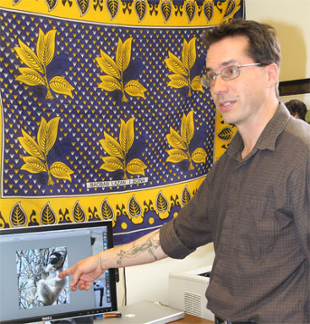JMU Researcher Seeks Answers to Long-Living Lemurs
NewsBy Alex Sharp VIII ('10), JMU Public Affairs

Remote Reserve Makes Ideal Laboratory
There are few distractions at the Beza Mahafaly Special Reserve, where meals are cooked over open fires and the researchers sleep in tents.
"Our field site has no running water, no electricity," Lawler said. "When there's no opportunity for the basic things you take for granted, you don't miss them as much as you think you would."—
More on Richard Lawler: www.propithecus-verreauxi.com
There's a general rule among mammals: the larger the body, the longer the lifespan. But a species of lemur, the sifaka of Madagascar, doesn't play by the rules. This biological rebel, about the size of a house cat, lives up to 35 years.
"This is not seen in the primate world," explains JMU assistant professor Richard Lawler, a primatologist specializing in lemur life history. Lawler cites humans, elephants and beluga whales among the longest-living mammals. "But if you control for body size, these guys are off the charts," Lawler said.
In November, the National Science Foundation (NSF) awarded Lawler a $200,000 grant to fund his on-going research of lemurs living in the Beza Mahafaly Special Reserve in southwestern Madagascar. Lawler collects physical and genetic data from lemurs to gain insight into how and why they live so long.
Since 1998, Lawler has travelled to Madagascar for one month a year to collect data on the sifaka. Working closely with an experienced team of Malagasy natives and other researchers—including JMU Associate Professor of biology Roshna Wunderlich—he has assisted in the safe capture and release of hundreds of sifaka.
"The major point of our grant is to understand the interplay between two fundamental factors that we know influence our biology: genes and environment," Lawler said, noting that any trait, whether it's height or intelligence, is going to have some combination of genetic influence and environmental influence. "And to estimate, or get at that question, you need to have a ton of long-term, year-to-year data on a large population of animals."
The Beza Mahafaly site offers both. Research on sifaka lemurs has been conducted there since the 1970s and the local sifaka population numbers around 700.
"It's an incredible data set that they have," said Wunderlich, who specializes in primate locomotion and has travelled to Madagascar with Lawler the past two years. "It's very rare, actually, in wild primates, to have all this morphological and genetic data over so many years." Wunderlich noted that two of the most famous primatologists, Jane Goodall and Dian Fossey, only studied troops of primates numbering less than 20.
Morphological and genetic data on the sifaka of Beza Mahafaly is the result of capture-and-release methods pioneered by Lawler and Wunderlich's advisor, Alison Richard, who has studied the sifaka lemur since the 1970s.
Every year, during the month that Lawler and other researchers are on site, he and a small team seek out and temporarily capture—using a blowgun and anesthetizing dart—unmarked sifakas. So far, about 700 have been captured, tagged and released.
Sifaka measurements and tissue samples are sent to Lawler's lab at JMU for genetic analysis. Using computer modeling, patterns of parenting are established to determine the mother and father of each sifaka. Based on patterns—such as tall parents produce tall offspring and long-living parents produce long-living offspring—genetic influences can be separated from physical influences on longevity.
"The fact that we can capture our animals and get tissue samples and then release them unharmed is absolutely key," Lawler said. "Plus, having marked animals is great. Sifaka tend to look alike, and when they're in trees, it's difficult to tell them apart."
Though it is common practice among primatologists, the research team doesn't name specific sifaka at Beza Mahafaly; that would be a daunting task.
"If we were more familiar with them, we could probably distinguish them by faces, but there's 700 of them," Lawler chuckled. "I don't even think I can do that in my own class."
The on-going research at Beza Mahafaly has significant implications for understanding the process of evolution, and not just for the evolution of lemurs.
"Humans are products of evolution," Lawler said. "And human longevity had to evolve through the same forces of evolution that all other creatures play by. And, given that humans live a very, very long time, and that sifakas live a very, very long time, characterizing the potential forces that shaped the evolution of lifespan in sifaka could answer a lot of questions about the human evolution of lifespan."

